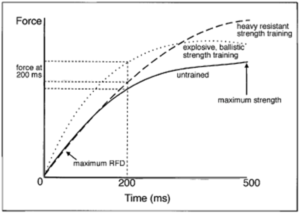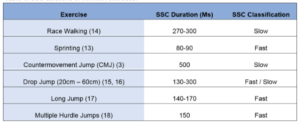What is it Rate of Force Development?
Rate of force development is defined as the rate of increase in force over time. We also call it “explosive strength” or how fast an athlete can develop force. It is one of the primary factors in success in many sports. These skills consist of jumping, sprinting, as well as other rapid movements where you have a limited time to produce force. While many forms of training have been shown to increase this in untrained individuals, only resistance training and ballistic training have been shown to do so in athletes. In the chart below, you can see the comparison of various training and the time to produce force. The quicker you can produce “X” amount of force, the faster you will be!

In considering this, we often look at what is called the “stretch-shortening cycle” or SSC. This is essentially an action which muscle goes under load to tension (eccentric contraction), transition (amortization) and a given action (concentric contraction). Sprinting shows a SSC of around 80-90 milliseconds (ms) while speed walking is around 300 ms. See the figure below comparing different activities and the time through the stretch-shortening cycle.

Exercise through larger joint range of motion places slower stretch and shortening of a particular joint. Consider a squat or countermovement jump as a slow stretch shortening cycle compared to sprinting. Do not ignore the importance of training through wider ranges of motion as it will develop greater movement quality, strength and motor control. Ignoring larger ranges will likely result in movement dysfunction and eventually an injury. That being said, in order to increase rate of force development, you want faster stretch and shortening of your joints to produce force quicker.
These changes in RFD are likely due to increases in muscle-tendon stiffness, changes in muscle fiber type resulting in increased muscle-force production, and trained readiness of your neurological system.
Here is a prime example:
To sum it up, RFD is a way to measure explosive strength with higher RFDs correlated with increased athletic performance. This results in increased muscle-tendon stiffness, changes in muscle fiber type and neurological readiness and ultimately increased speed and acceleration. Although many forms of training can help with this goal, only resistance training and high intensity training have been shown to accomplish this goal in athletes.
Sign up for our FREE Newsletter
Recieve performance physical thearpy, nutrition and training tips!

